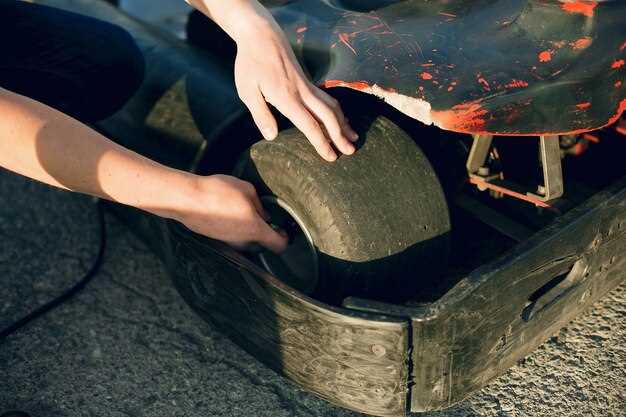
Off-roading is an exhilarating activity that offers the thrill of exploring rugged terrains and untouched landscapes. However, it also presents unique challenges and risks that require careful consideration of safety gear. The right equipment not only enhances your comfort during the adventure but also provides essential protection against potential injuries.
When venturing into off-road environments, one must prioritize wearing proper safety gear. This includes helmets, gloves, protective clothing, and appropriate footwear. Each piece of equipment plays a critical role in safeguarding against cuts, abrasions, and impacts that can occur in unpredictable terrains.
Furthermore, understanding the specific conditions of your off-roading environment is essential in selecting the right gear. Whether you’re navigating rocky trails, muddy paths, or sandy dunes, the demands on your safety equipment may differ significantly. Therefore, investing time in researching and choosing the best safety gear tailored to your off-roading adventures is crucial for ensuring a safe and enjoyable experience.
Understanding the Importance of Helmets for Off-Roading
Helmets are a critical piece of safety gear for off-roading enthusiasts, providing essential protection in a high-risk environment where accidents can happen unexpectedly. The primary function of a helmet is to absorb impact energy, reducing the force transmitted to the skull and brain during a collision or fall. This can significantly decrease the likelihood of severe head injuries, including concussions or skull fractures.
Off-road riding often involves navigating rugged terrain, which increases the risk of falls and collisions. Helmets designed for this purpose are typically constructed with materials that offer high durability and shock-absorbing capabilities. Features such as a snug fit, a visor to shield the eyes from debris, and ventilation systems contribute to both safety and comfort during long rides.
Another important aspect of helmets is their ability to enhance visibility. Many models come in bright colors or have reflective elements that make riders more noticeable to others, such as fellow off-roaders and vehicle drivers. This heightened visibility is crucial in mitigating risks, especially in areas where traffic may intersect with off-road paths.
Additionally, properly fitted helmets can help prevent neck injuries. In the event of a sudden stop or impact, a well-designed helmet can reduce the risk of whiplash by providing stability to the head. Riders must ensure that their helmets meet safety standards and are appropriate for their specific riding conditions.
In summary, wearing a helmet while off-roading is not only about compliance with safety regulations but a fundamental practice that can save lives. It protects against a variety of potential injuries and enhances the overall riding experience by allowing riders to focus on the adventure rather than worrying about safety concerns.
Choosing the Right Protective Clothing for Different Terrains
When embarking on off-roading adventures, selecting the appropriate protective clothing is crucial for ensuring safety and comfort across various terrains. Each environment presents unique challenges, and the right gear can make all the difference in your experience.
Mud and Wet Conditions: In muddy terrains, opt for waterproof and breathable materials. A good choice would be a durable rain jacket paired with waterproof pants. These will keep you dry while allowing moisture to escape, reducing sweat buildup. Additionally, consider wearing rubber boots that provide grip and prevent slipping.
Desert and Hot Environments: For off-roading in deserts, lightweight, breathable fabrics are essential. Look for long-sleeved shirts and pants made from moisture-wicking materials to protect against sunburn and dehydration. A wide-brimmed hat and UV-protective sunglasses are crucial for safeguarding against harsh sun exposure.
Rocky and Rough Terrain: When navigating rocky paths, prioritize abrasion-resistant clothing. Long pants and shirts should be made of tough materials that can withstand scrapes and cuts. Reinforced knee pads and elbow guards are highly recommended to provide additional protection against falls.
Snow and Cold Conditions: In snowy or cold environments, thermal layers are vital. Choose insulated jackets and pants that provide warmth without excess bulk. Waterproof outer layers will help keep moisture at bay. Don’t forget gloves and a thermal hat to protect exposed skin from the cold.
In all cases, ensure that your clothing fits well and allows for full range of motion. Selecting gear that combines protection with comfort will enhance your off-roading adventures, making them safer and more enjoyable.
Assessing Footwear Options for Traction and Protection

When venturing into off-roading, selecting the right footwear is crucial for ensuring safety and stability. Footwear serves two primary purposes: providing traction on uneven surfaces and protecting the feet from potential hazards.
Traction is essential when navigating challenging terrains. Shoes with specialized outsoles enhance grip on a variety of surfaces, including mud, gravel, and rocks. Deep lugs positioned strategically can help to prevent slipping and improve stability. Consider the following characteristics when assessing footwear options:
| Feature | Description |
|---|---|
| Outsole Material | Look for rubber compounds that offer durability and grip. The right material can significantly affect traction on wet or slippery surfaces. |
| Lug Depth | Deeper lugs provide better grip in loose or muddy conditions. A range between 4-6mm is typically ideal for off-road environments. |
| Tread Pattern | A multi-directional tread pattern can enhance grip while allowing mud and debris to be expelled easily, keeping the surface clear for better traction. |
Protection is another vital factor when choosing footwear for off-roading. The footwear should shield against sharp objects, impact, and moisture. Key protective features include:
| Feature | Description |
|---|---|
| Toe Cap | A reinforced toe cap can protect against rocks and other obstacles. Steel or composite options offer varying degrees of safety and weight. |
| Water Resistance | Waterproof materials keep the feet dry in wet conditions, preventing blisters and enhancing comfort during extended adventures. |
| Support and Cushioning | Proper arch support and cushioning prevent fatigue and minimize the risk of injury during long treks over rugged terrain. |
In conclusion, careful evaluation of traction and protection features in footwear is essential for a successful off-roading experience. Always consider the specific conditions you will encounter and choose options that provide the best balance between grip and safety to enjoy your adventures without compromising your well-being.
Evaluating the Need for Body Armor in Challenging Conditions
When it comes to off-roading, challenging conditions can significantly increase the risk of injury. Evaluating whether body armor is necessary involves considering various factors such as terrain, vehicle type, and individual riding experience.
The terrain plays a critical role in determining the need for body armor. Rocky, uneven surfaces or areas with dense vegetation can lead to falls or collisions, increasing the chances of blunt force trauma. In contrast, smoother trails may require less protective gear. Riders traversing extreme environments, such as steep hills or deep mud, should prioritize body armor to safeguard against unforeseen crashes.
The type of vehicle also influences armor requirements. Drivers of ATVs or dirt bikes, which are inherently more unstable, might find it essential to wear more comprehensive protective gear. Conversely, those in larger off-road vehicles, like 4×4 trucks, may require less armor due to the enclosed nature of their ride. Nonetheless, accidents can happen, and having body armor can provide additional assurance of safety.
Individual experience levels are another crucial consideration. Novice riders may be less adept at handling their vehicles and thus face a higher likelihood of accidents. In this case, body armor is advisable for added protection. Experienced riders, while often more skilled, can encounter unpredictable situations that still warrant body armor for safety. Therefore, self-assessment of skill and comfort with the vehicle is vital in the decision-making process.
Ultimately, evaluating the need for body armor is about balancing risk versus comfort. Riders should assess their route, vehicle, and skills to make an informed decision. Investing in quality body armor can enhance safety and boost confidence, enabling riders to focus on the adventure ahead.
Utilizing Gloves Designed for Handling Off-Road Equipment
When heading into off-road adventures, selecting the right gloves is crucial for safety and performance. Specially designed gloves for handling off-road equipment not only enhance grip but also provide protection from various elements encountered on rugged terrains.
Here are some key features to consider when choosing off-road gloves:
- Material: Look for gloves made from durable materials such as synthetic leather, neoprene, or reinforced fabrics. These materials offer resistance to abrasion and safeguard against sharp objects.
- Grip: Opt for gloves with textured palms and fingers. This design improves grip on tools and handlebars, ensuring you maintain control even in wet or muddy conditions.
- Padding: Gloves with padded knuckles and palms provide extra protection from impacts and vibrations, which can be common when operating off-road vehicles and equipment.
- Breathability: Choose gloves that feature breathable fabric or mesh panels. This helps to keep your hands cool and dry during strenuous activities.
- Adjustable Fit: Look for gloves with adjustable closures, such as Velcro straps or elastic cuffs, to ensure a snug fit that prevents debris from entering.
In addition to these features, it is essential to ensure that the gloves permit flexibility and dexterity. You will need to manipulate controls and tools effectively while off-roading, which requires a well-fitted glove that does not restrict movement.
When selecting gloves for off-roading, consider the following types:
- Mechanics Gloves: These provide excellent grip and dexterity, making them ideal for working on machines and vehicles.
- All-Weather Gloves: Suitable for varied weather conditions, offering insulation for cold climates while maintaining breathability.
- Protective Gloves: Heavy-duty gloves designed to withstand the rigors of harsh environments, with extra cushioning for hand protection.
Using the right gloves designed for off-road equipment enhances your overall experience and safety. They are not just an accessory; they are an essential part of your safety gear that can make a significant difference in your off-roading adventures.
Investing in Communication Devices for Safety on the Trails
When embarking on off-roading adventures, ensuring effective communication can be as critical as wearing the right safety gear. Communication devices not only facilitate contact among group members but also serve as lifelines in emergency situations. Investing in reliable communication technology is essential for safety on rugged trails.
Walkie-talkies and two-way radios are popular choices for off-road groups. These devices provide instant communication without relying on cellular networks, which are often unreliable in remote areas. Look for models with long battery life and good range to ensure they perform well in various terrains. Features such as weather alerts and durable construction can enhance their reliability.
For more advanced communication, consider satellite phones or satellite messengers. These devices allow for global communication, making them invaluable in emergencies where traditional signals fail. Satellite messengers often include GPS functions, enabling you to send your location to friends or rescue services. While more expensive, they offer peace of mind when venturing into isolated areas.
Smartphone apps can also play a role in communication on off-road trails. Many apps provide offline map capabilities and allow users to share locations, making it easier to coordinate with the group. However, ensure that all members have downloaded the necessary maps before hitting the trail, as cellular service may be spotty.
Lastly, establishing a communication protocol is crucial for ensuring that the technology is used effectively. Set intervals for check-ins and protocols for emergencies to ensure that everyone knows how to respond in critical situations. Training your group on the use of these devices before heading out can also enhance safety and efficiency.
In conclusion, investing in the right communication devices can significantly enhance safety during off-roading adventures. From walkie-talkies to satellite phones, each option has its benefits and can be tailored to meet the specific needs of your group, ensuring a safer experience on the trails.

